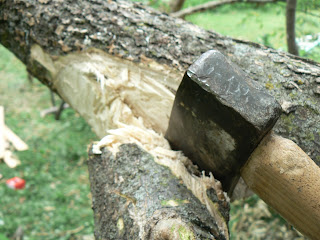When the wind took down the two hack berry trees in May, large limbs were permanently pressed against the earth. I have harvested these long thick limbs with handsaw and hatchet. The one by four planks I am using require a brace underneath for the span they cross.
Accessing the limbs I have, and figuring out how best to butt it and nailed together. I've been pleased how particular parts have fit. Grateful to Jesus for his help. The energy to hold elements in place, the endurance to hammer and nail, the balance to chop with my hatchet, to sweat and persist and succeed.
With ground limbs out of the way there is more freedom for my tall 62 year old frame. Fewer protrusions above my head to run into. Ha. Ouch.
At first I only focused on a high platform on the north end. Dreaming that one day I might perch up there myself. The steel ladder is too clumsy and too large to maneuver from within. But I did manage one day and carefully rose the steel rungs to view the "said platform." And guess what? The space was much smaller than I imagined it to be. A six-foot man does not belong in that space. The younger version inside me says to hold out hope.
Those are one by fours from the local lumber yard.
From the beginning I've been trying to figure "a path up" to the "high platform." The fallen trees lie on their side in my yard. Everything is parallel to the ground and inclines go this way and that. I shared my dilemma with Tad. The third grader-to-be pointed straight up. He likes the idea to make the ladder go from the ground straight up to the platform. The next week I located one solid branch to fit that bill. The other vertical had many smaller branches on it. I hog-tied the smaller branches in next to the core with clothesline. Got the entire package jigsaw positioned vertical, threaded upward between the fork of other lofty branches. IT WORKED.
The jury is out on the "ladder rungs." I nailed one inch branches that I could not bend. The boy will test that out next time he visits. Am hoping he is lightweight enough to successfully rise.
Last week I turned my attention to the south end. My goal: a platform just three feet off the ground, between the two hack berry trunks. A place to be within his capacity and mine, and anyone else for that matter. It is not shaded. The sun makes that area very hot. Working towards that solution.
Still under wraps is the short path, above. My hope is to see what ideas come out of the boy.
No power tools here. My short hand saw, the hammer, and the hatchet.







































